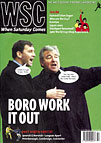 The sports minister reopens the debate on safe standing
The sports minister reopens the debate on safe standing
There used to be a sign over the stairs leading out of the away end at Upton Park urging supporters to “Remember Ibrox” and leave without pushing. It seemed pretty rich, back in the Eighties, when spectators would struggle to get out of that tangle of unforgiving fences and barriers in one piece.
Remembering Ibrox is not something British football has done very well. The disaster that took place there 30 years ago this month killed 66 people. Yet it changed relatively little, except of course for Ibrox itself. Perhaps if it had happened in England at a ground thought to be safe and modern (like, say, Hillsborough) the impact would have been different. But going down the stairs at Ibrox was known to be a dangerous business even before 1971. It was easy enough to assume it was a one-off.
The Safety of Sports Grounds Act was brought in as a result of the disaster but, in an era of rapidly declining attendances, clubs were often more concerned with the costs it imposed on them rather than any opportunities it opened up for changing the way people watched football. Besides, hooliganism quickly overtook safety as the No 1 crowd control issue, with the result that fences went up and grounds, as we later discovered, became more, not less, dangerous.
It’s hard to believe that Sports Minister Kate Hoey had remembered it was the anniversary of Ibrox a week after she appeared on TV to announce that she was in favour of reintroducing terracing at big grounds in Britain. “I think what we’re not prepared to have a rethink on is going back to what it used to be in terms of huge terraces, very badly controlled and in very bad condition,” she said. “What this is about is whether it is possible – if the clubs want it and supporters want it – to have pilots of safe standing areas, very small and very well controlled.”
It’s not that Ibrox or Hillsborough should rule out having a debate about terracing. It’s just that they conjure up images of terracing that are not at all what the proponents of its reintroduction have in mind. And it’s hard to argue with the families or friends of people killed in football grounds that anyone is being seriously disadvantaged by having to sit down to watch their team.
There are some perfectly respectable arguments for the return of terracing in a limited form, most of which have been expressed by SAFE (www.footballsupporter.net/safe), the campaign which began with the intention of opening up debate on Manchester City’s new stadium at Eastlands. Among them are that it might provide opportunities for people currently excluded from stadiums either by high prices or “house full” signs to attend more often; that it might improve the atmosphere; and that it would reduce conflicts between the type of fan who wants to sit and those who want to stand whether terraces are provided or not.
Standing, it is claimed, is still regarded as perfectly normal and desirable in Germany, where most big clubs have some kind of system for converting their terraces to seating for European games, for which standing is forbidden by UEFA. This is true, although the sophistication of such devices is perhaps not quite as great as the terracists would like to believe.
In truth it’s hard to embrace the campaign for safe standing with any great enthusiasm. Given the rigorous safety standards that would have to be applied to them, the density of people standing on a terrace would not be all that much greater than if they each occupied a seat. Certainly not so great, you wouldn’t think, that clubs would go to the trouble of converting parts of their current ground for standing and reduce prices substantially for those areas, on the premise that they would make more money from the overall increase in attendance.
Perhaps terraces would bring back some of the old atmosphere. But what parts of it, exactly? More singing and chanting, for sure, but who is to say that terraces, less easily monitored by stewards or police, would not become a happy hang-out for the kind of fans the government is currently trying actively to dissuade from following England.
These are all debateable points. There is no single right answer to the question of terracing. Few people, for example, could argue that it makes logical sense to allow terracing for matches involving clubs as big as Stoke or Bristol City just because they are in the Second Division, but not for games at Crewe or Grimsby in the First.
But in the end the spectre of Hillsborough will always haunt the debate. However safe standing can be made – and it certainly can be done well in certain circumstances – no one will want to take the responsibility for something going horribly wrong again. We didn’t remember well enough after Ibrox. If we’re over-cautious as a consequence of Hillsborough, maybe that’s not such a bad thing.
From WSC 168 February 2001. What was happening this month